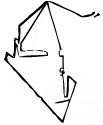 |
| Chris Jordan, Unsinkable, 2013 |
One of the most effective ways to represent the idea of wealth in western countries, with all its consequences, side effects and by-products, is probably Chris Jordan's ongoing project Running the Numbers: An American Self-Portrait
, which he started in 2006. Every image is a gigantic mosaic often showing pretty ordinary pictures, sometimes familiar to all of us; the two most recent, from 2013, respectively show the sinking of the Titanic and a wall of building blocks.
But the more you look into those pictures, the more they reveal the fabric they are made of: the picture of the infamous ocean liner is in fact made of photographs of 67.000 mushroom clouds, "equal to the number of metric tons of ultra-radioactive
uranium/plutonium waste being stored in temporary pools at the 104
nuclear power plants across the U.S", as Jordan informs us. The second is a composition of 1.2 million children’s building blocks, equal to the number of students
who drop out of high school every year in the U.S. This averages about
7000 students per school day".
"Statistics can feel abstract and anesthetizing, making it difficult to
connect with and make meaning of 3.6 million SUV sales in one year, for
example, or 2.3 million Americans in prison, or 32,000 breast
augmentation surgeries in the U.S. every month", writes Jordan. "Employing themes such as the near versus the
far, and the one versus the many, I hope to raise some questions about
the roles and responsibilities we each play as individuals in a
collective that is increasingly enormous, incomprehensible, and
overwhelming".
 |
| Chris Jordan, Unsinkable, 2013 (detail) |
Uno dei modi più efficaci per esprimere l'idea di ricchezza così come si manifesta nelle società occidentali, con tutto il suo corredo di effetti collaterali, conseguenze e sottoprodotti, è probabilmente
Running the Numbers: An American Self-Portrait, un progetto iniziato nel 2006 da
Chris Jordan. Ogni opera si presenta come un gigantesco mosaico di immagini spesso banali o conosciute; due delle più recenti mostrano ad esempio rispettivamente il naufragio del Titanic e una parete di mattoncini per bambini.
Ma più si entra nelle immagini e più emerge la trama reale di cui sono composte: il Titanic è in realtà una composizione di 67000 fotografie di funghi atomici, "l'equivalente del numero di tonnellate di uranio e plutonio ultraradioattivi stoccate nelle 104 centrali nucleari degli Stati Uniti", come ci informa Jordan. La seconda è una composizione di 1.200.000 mattoncini, "corrispondenti al numero di studenti che abbandonano la scuola superiore ogni anno negli Stati Uniti, una media di 7000 studenti al giorno".
 |
| Chris Jordan, Building Blocks, 2013 |
"Le statistiche possono risultare astratte o anestetizzanti, rendendo difficile il provare a comprendere il senso di 3,6 milioni di SUV venduti ogni anno, o 2,3 milioni di americani rinchiusi in carcere, o 32.000 chirurgie plastiche al seno ogni mese", scrive Jordan. "Utilizzando concetti come il lontano e il vicino, e il singolo rispetto alla moltitudine, spero di sollevare alcune questioni sul ruolo e la responsabilità che abbiamo tutti in quanto individui di una collettività che è sempre più grande, incomprensibile e schiacciante".
 |
| Chris Jordan, Building Blocks, 2013 (detail) |
|
Read More...




